Case Study Analysis: Nutrition Crisis and Programs in India, HMG7130
VerifiedAdded on 2023/03/23
|14
|3783
|83
Case Study
AI Summary
This case study analyzes the critical nutrition problems in India, focusing on the significant challenges of malnutrition and its impact on vulnerable groups such as children under five, pregnant women, and lactating mothers. The study outlines the nutrition situation, identifying major issues like protein-energy malnutrition, vitamin deficiencies, and anemia, while highlighting the severe health, social, and economic consequences. It delves into the causes of malnutrition, including low socioeconomic status, inadequate food production, lack of healthcare facilities, cultural influences, and high illiteracy levels, connecting these factors within the UNICEF framework. The analysis emphasizes the need for interventions targeting pregnant and lactating women and children under five and examines the Integrated Child Development Services (ICDS) scheme as a successful program. The study details the program's components, its interventions at various levels within the UNICEF framework, and the key elements contributing to its success, including government, UNICEF, World Bank, Anganwadi workers, and community involvement. The essay effectively demonstrates the interconnectedness of factors contributing to malnutrition and the importance of comprehensive, multi-level interventions to address this pressing public health issue.
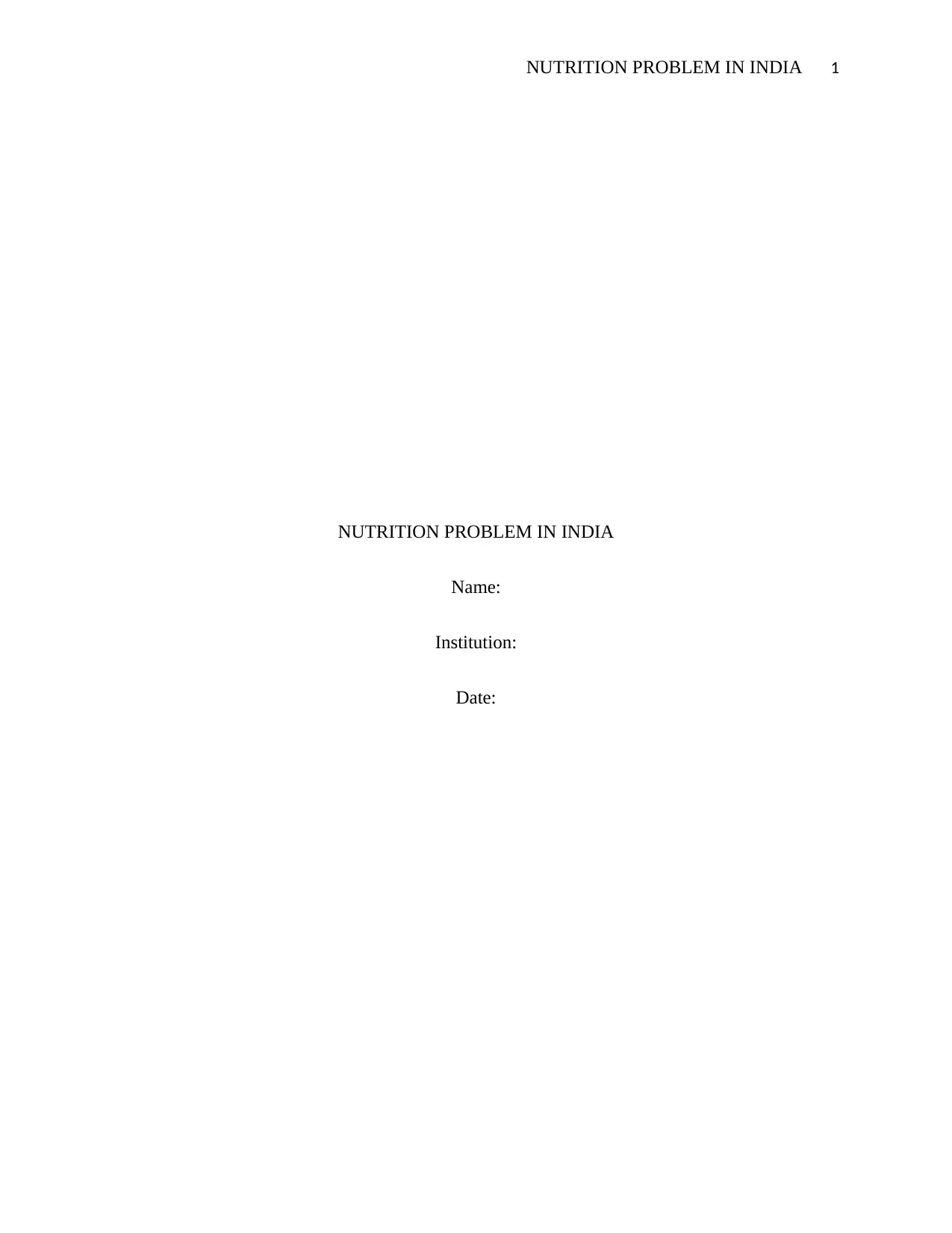
NUTRITION PROBLEM IN INDIA 1
NUTRITION PROBLEM IN INDIA
Name:
Institution:
Date:
NUTRITION PROBLEM IN INDIA
Name:
Institution:
Date:
Paraphrase This Document
Need a fresh take? Get an instant paraphrase of this document with our AI Paraphraser
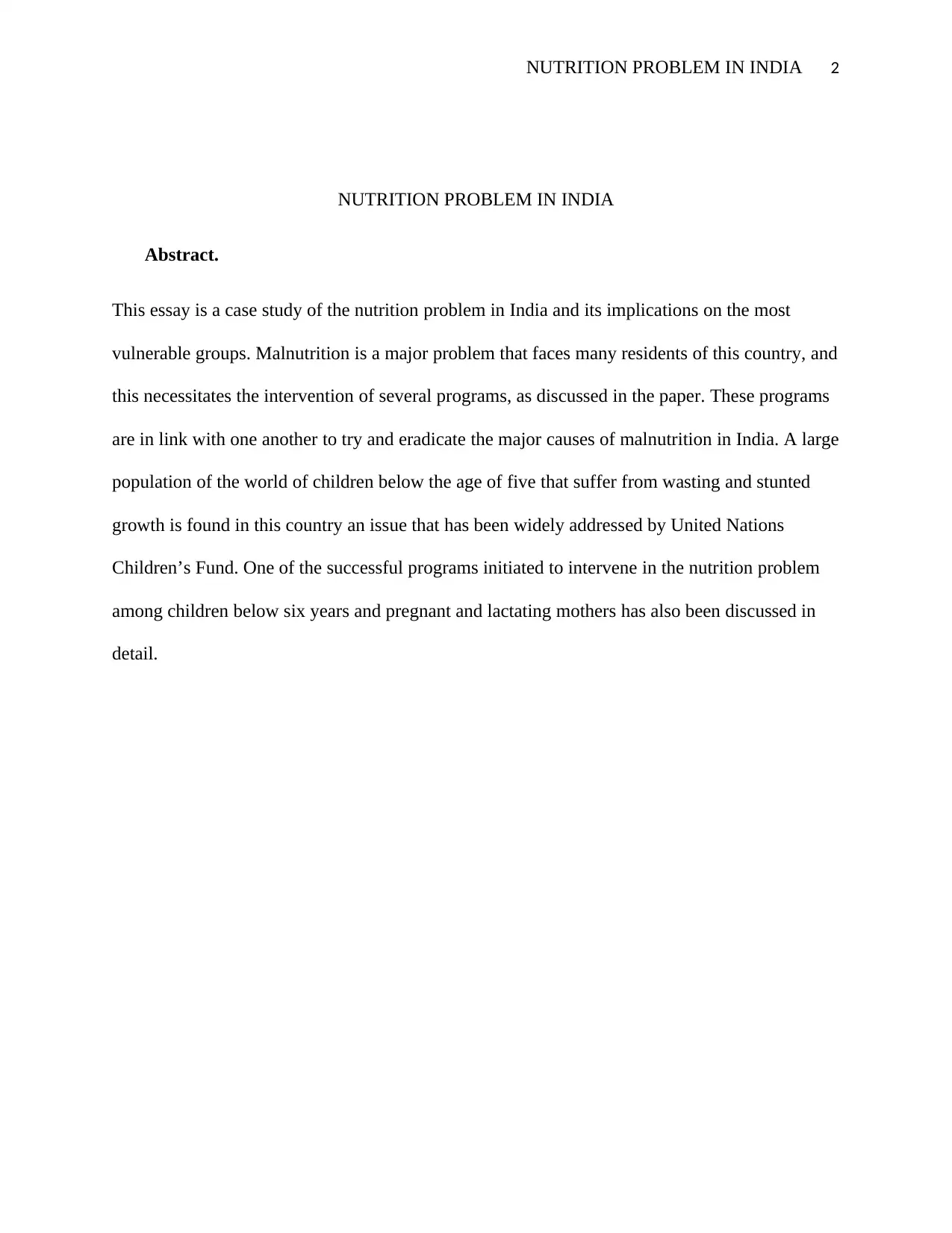
NUTRITION PROBLEM IN INDIA 2
NUTRITION PROBLEM IN INDIA
Abstract.
This essay is a case study of the nutrition problem in India and its implications on the most
vulnerable groups. Malnutrition is a major problem that faces many residents of this country, and
this necessitates the intervention of several programs, as discussed in the paper. These programs
are in link with one another to try and eradicate the major causes of malnutrition in India. A large
population of the world of children below the age of five that suffer from wasting and stunted
growth is found in this country an issue that has been widely addressed by United Nations
Children’s Fund. One of the successful programs initiated to intervene in the nutrition problem
among children below six years and pregnant and lactating mothers has also been discussed in
detail.
NUTRITION PROBLEM IN INDIA
Abstract.
This essay is a case study of the nutrition problem in India and its implications on the most
vulnerable groups. Malnutrition is a major problem that faces many residents of this country, and
this necessitates the intervention of several programs, as discussed in the paper. These programs
are in link with one another to try and eradicate the major causes of malnutrition in India. A large
population of the world of children below the age of five that suffer from wasting and stunted
growth is found in this country an issue that has been widely addressed by United Nations
Children’s Fund. One of the successful programs initiated to intervene in the nutrition problem
among children below six years and pregnant and lactating mothers has also been discussed in
detail.
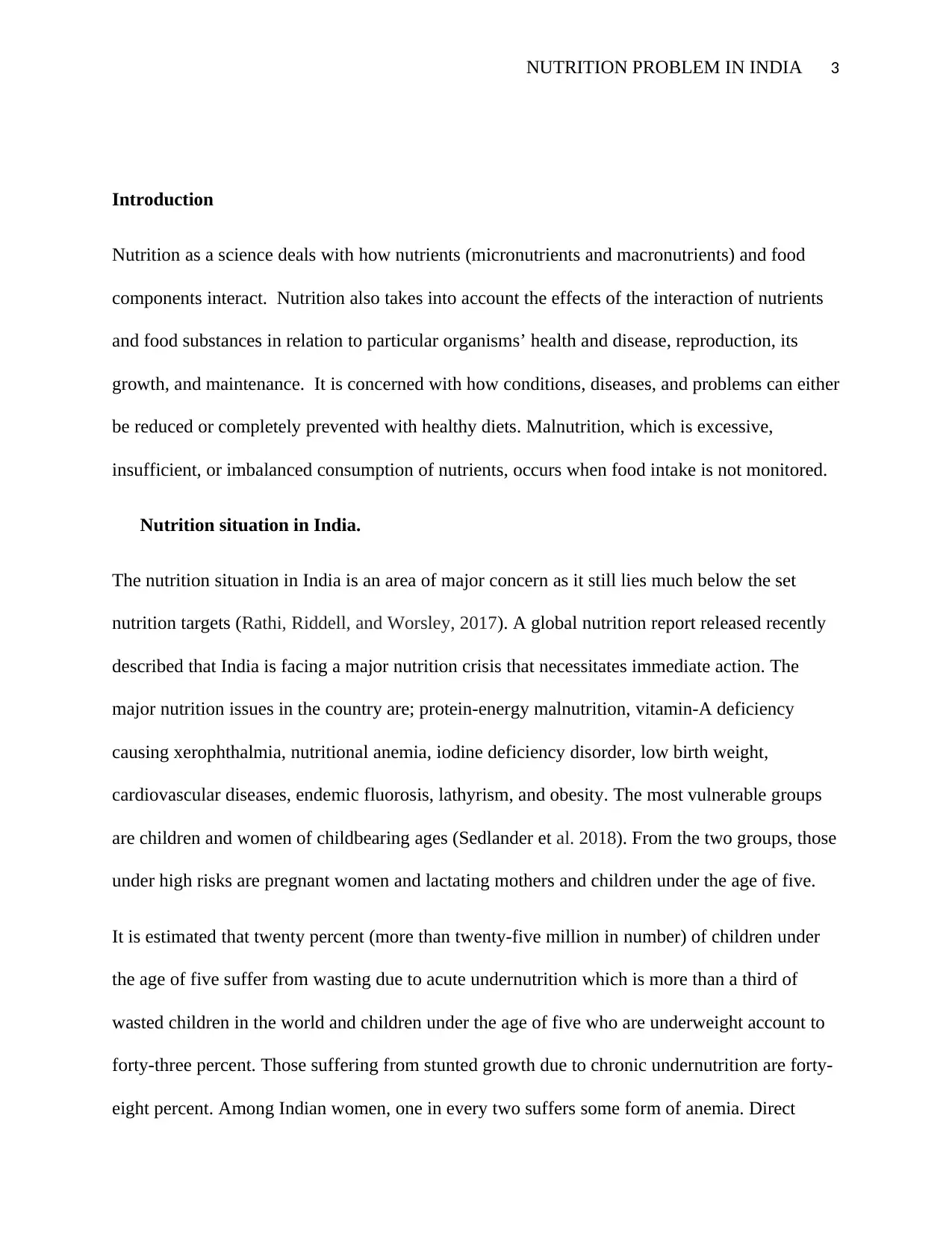
NUTRITION PROBLEM IN INDIA 3
Introduction
Nutrition as a science deals with how nutrients (micronutrients and macronutrients) and food
components interact. Nutrition also takes into account the effects of the interaction of nutrients
and food substances in relation to particular organisms’ health and disease, reproduction, its
growth, and maintenance. It is concerned with how conditions, diseases, and problems can either
be reduced or completely prevented with healthy diets. Malnutrition, which is excessive,
insufficient, or imbalanced consumption of nutrients, occurs when food intake is not monitored.
Nutrition situation in India.
The nutrition situation in India is an area of major concern as it still lies much below the set
nutrition targets (Rathi, Riddell, and Worsley, 2017). A global nutrition report released recently
described that India is facing a major nutrition crisis that necessitates immediate action. The
major nutrition issues in the country are; protein-energy malnutrition, vitamin-A deficiency
causing xerophthalmia, nutritional anemia, iodine deficiency disorder, low birth weight,
cardiovascular diseases, endemic fluorosis, lathyrism, and obesity. The most vulnerable groups
are children and women of childbearing ages (Sedlander et al. 2018). From the two groups, those
under high risks are pregnant women and lactating mothers and children under the age of five.
It is estimated that twenty percent (more than twenty-five million in number) of children under
the age of five suffer from wasting due to acute undernutrition which is more than a third of
wasted children in the world and children under the age of five who are underweight account to
forty-three percent. Those suffering from stunted growth due to chronic undernutrition are forty-
eight percent. Among Indian women, one in every two suffers some form of anemia. Direct
Introduction
Nutrition as a science deals with how nutrients (micronutrients and macronutrients) and food
components interact. Nutrition also takes into account the effects of the interaction of nutrients
and food substances in relation to particular organisms’ health and disease, reproduction, its
growth, and maintenance. It is concerned with how conditions, diseases, and problems can either
be reduced or completely prevented with healthy diets. Malnutrition, which is excessive,
insufficient, or imbalanced consumption of nutrients, occurs when food intake is not monitored.
Nutrition situation in India.
The nutrition situation in India is an area of major concern as it still lies much below the set
nutrition targets (Rathi, Riddell, and Worsley, 2017). A global nutrition report released recently
described that India is facing a major nutrition crisis that necessitates immediate action. The
major nutrition issues in the country are; protein-energy malnutrition, vitamin-A deficiency
causing xerophthalmia, nutritional anemia, iodine deficiency disorder, low birth weight,
cardiovascular diseases, endemic fluorosis, lathyrism, and obesity. The most vulnerable groups
are children and women of childbearing ages (Sedlander et al. 2018). From the two groups, those
under high risks are pregnant women and lactating mothers and children under the age of five.
It is estimated that twenty percent (more than twenty-five million in number) of children under
the age of five suffer from wasting due to acute undernutrition which is more than a third of
wasted children in the world and children under the age of five who are underweight account to
forty-three percent. Those suffering from stunted growth due to chronic undernutrition are forty-
eight percent. Among Indian women, one in every two suffers some form of anemia. Direct
⊘ This is a preview!⊘
Do you want full access?
Subscribe today to unlock all pages.

Trusted by 1+ million students worldwide
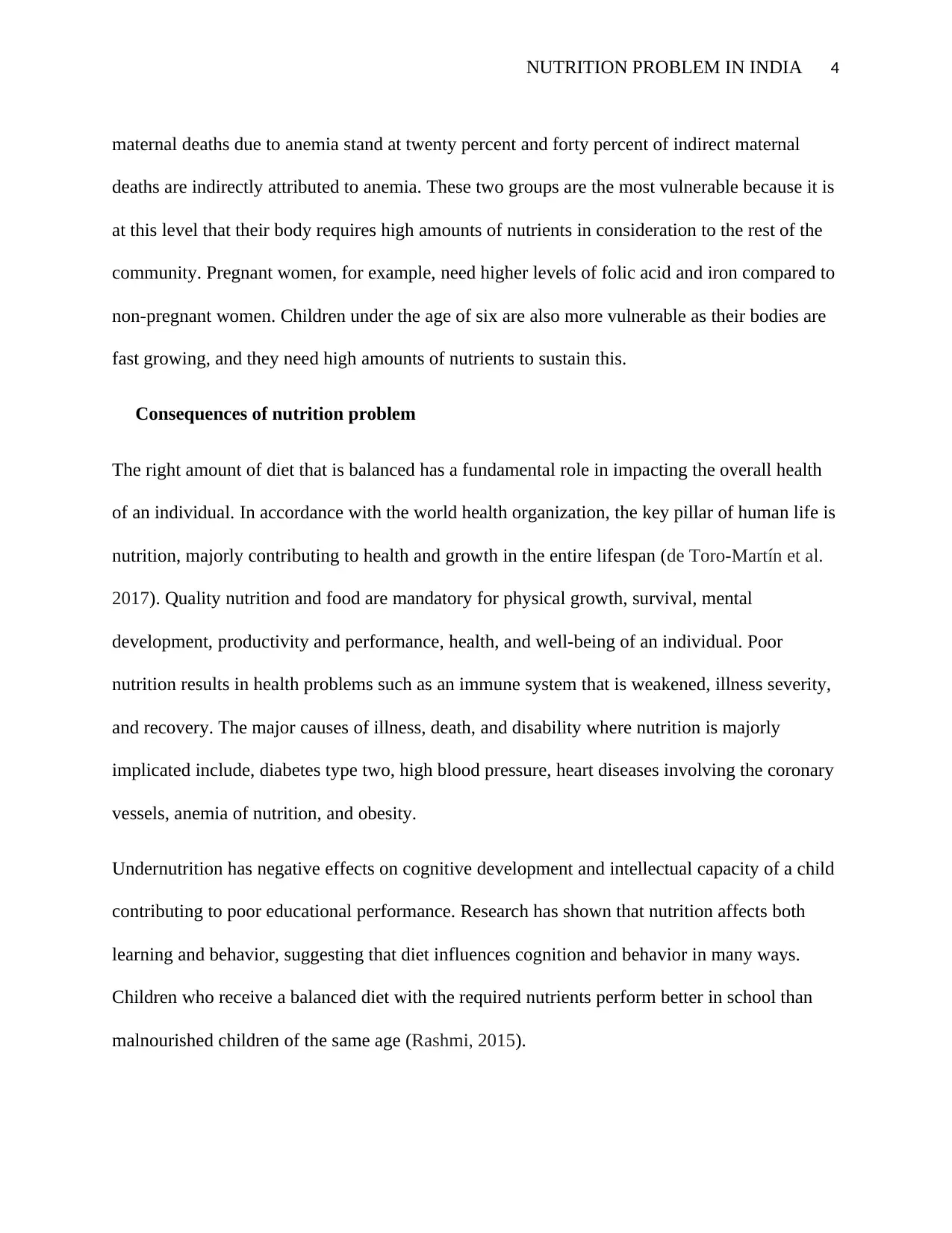
NUTRITION PROBLEM IN INDIA 4
maternal deaths due to anemia stand at twenty percent and forty percent of indirect maternal
deaths are indirectly attributed to anemia. These two groups are the most vulnerable because it is
at this level that their body requires high amounts of nutrients in consideration to the rest of the
community. Pregnant women, for example, need higher levels of folic acid and iron compared to
non-pregnant women. Children under the age of six are also more vulnerable as their bodies are
fast growing, and they need high amounts of nutrients to sustain this.
Consequences of nutrition problem
The right amount of diet that is balanced has a fundamental role in impacting the overall health
of an individual. In accordance with the world health organization, the key pillar of human life is
nutrition, majorly contributing to health and growth in the entire lifespan (de Toro-Martín et al.
2017). Quality nutrition and food are mandatory for physical growth, survival, mental
development, productivity and performance, health, and well-being of an individual. Poor
nutrition results in health problems such as an immune system that is weakened, illness severity,
and recovery. The major causes of illness, death, and disability where nutrition is majorly
implicated include, diabetes type two, high blood pressure, heart diseases involving the coronary
vessels, anemia of nutrition, and obesity.
Undernutrition has negative effects on cognitive development and intellectual capacity of a child
contributing to poor educational performance. Research has shown that nutrition affects both
learning and behavior, suggesting that diet influences cognition and behavior in many ways.
Children who receive a balanced diet with the required nutrients perform better in school than
malnourished children of the same age (Rashmi, 2015).
maternal deaths due to anemia stand at twenty percent and forty percent of indirect maternal
deaths are indirectly attributed to anemia. These two groups are the most vulnerable because it is
at this level that their body requires high amounts of nutrients in consideration to the rest of the
community. Pregnant women, for example, need higher levels of folic acid and iron compared to
non-pregnant women. Children under the age of six are also more vulnerable as their bodies are
fast growing, and they need high amounts of nutrients to sustain this.
Consequences of nutrition problem
The right amount of diet that is balanced has a fundamental role in impacting the overall health
of an individual. In accordance with the world health organization, the key pillar of human life is
nutrition, majorly contributing to health and growth in the entire lifespan (de Toro-Martín et al.
2017). Quality nutrition and food are mandatory for physical growth, survival, mental
development, productivity and performance, health, and well-being of an individual. Poor
nutrition results in health problems such as an immune system that is weakened, illness severity,
and recovery. The major causes of illness, death, and disability where nutrition is majorly
implicated include, diabetes type two, high blood pressure, heart diseases involving the coronary
vessels, anemia of nutrition, and obesity.
Undernutrition has negative effects on cognitive development and intellectual capacity of a child
contributing to poor educational performance. Research has shown that nutrition affects both
learning and behavior, suggesting that diet influences cognition and behavior in many ways.
Children who receive a balanced diet with the required nutrients perform better in school than
malnourished children of the same age (Rashmi, 2015).
Paraphrase This Document
Need a fresh take? Get an instant paraphrase of this document with our AI Paraphraser
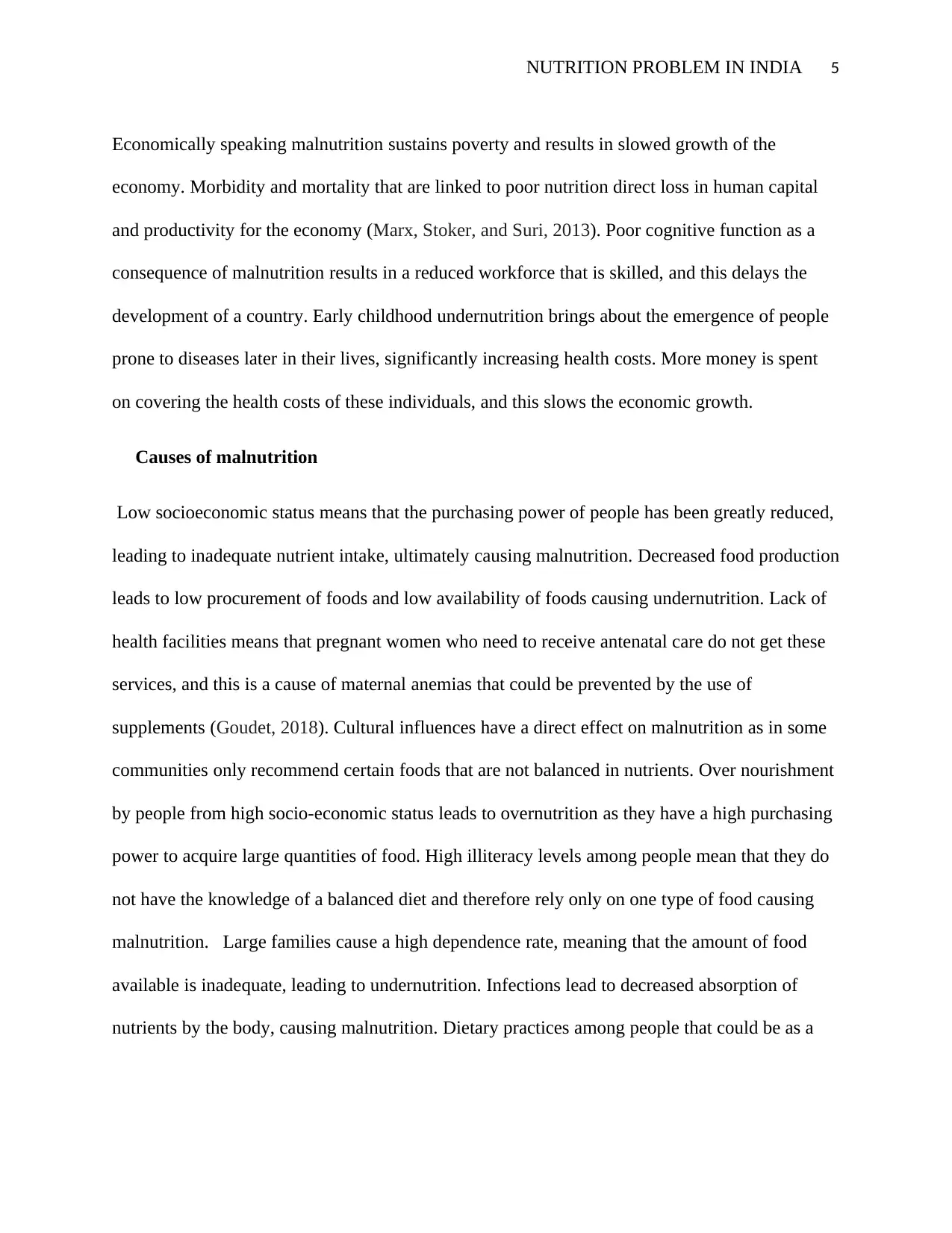
NUTRITION PROBLEM IN INDIA 5
Economically speaking malnutrition sustains poverty and results in slowed growth of the
economy. Morbidity and mortality that are linked to poor nutrition direct loss in human capital
and productivity for the economy (Marx, Stoker, and Suri, 2013). Poor cognitive function as a
consequence of malnutrition results in a reduced workforce that is skilled, and this delays the
development of a country. Early childhood undernutrition brings about the emergence of people
prone to diseases later in their lives, significantly increasing health costs. More money is spent
on covering the health costs of these individuals, and this slows the economic growth.
Causes of malnutrition
Low socioeconomic status means that the purchasing power of people has been greatly reduced,
leading to inadequate nutrient intake, ultimately causing malnutrition. Decreased food production
leads to low procurement of foods and low availability of foods causing undernutrition. Lack of
health facilities means that pregnant women who need to receive antenatal care do not get these
services, and this is a cause of maternal anemias that could be prevented by the use of
supplements (Goudet, 2018). Cultural influences have a direct effect on malnutrition as in some
communities only recommend certain foods that are not balanced in nutrients. Over nourishment
by people from high socio-economic status leads to overnutrition as they have a high purchasing
power to acquire large quantities of food. High illiteracy levels among people mean that they do
not have the knowledge of a balanced diet and therefore rely only on one type of food causing
malnutrition. Large families cause a high dependence rate, meaning that the amount of food
available is inadequate, leading to undernutrition. Infections lead to decreased absorption of
nutrients by the body, causing malnutrition. Dietary practices among people that could be as a
Economically speaking malnutrition sustains poverty and results in slowed growth of the
economy. Morbidity and mortality that are linked to poor nutrition direct loss in human capital
and productivity for the economy (Marx, Stoker, and Suri, 2013). Poor cognitive function as a
consequence of malnutrition results in a reduced workforce that is skilled, and this delays the
development of a country. Early childhood undernutrition brings about the emergence of people
prone to diseases later in their lives, significantly increasing health costs. More money is spent
on covering the health costs of these individuals, and this slows the economic growth.
Causes of malnutrition
Low socioeconomic status means that the purchasing power of people has been greatly reduced,
leading to inadequate nutrient intake, ultimately causing malnutrition. Decreased food production
leads to low procurement of foods and low availability of foods causing undernutrition. Lack of
health facilities means that pregnant women who need to receive antenatal care do not get these
services, and this is a cause of maternal anemias that could be prevented by the use of
supplements (Goudet, 2018). Cultural influences have a direct effect on malnutrition as in some
communities only recommend certain foods that are not balanced in nutrients. Over nourishment
by people from high socio-economic status leads to overnutrition as they have a high purchasing
power to acquire large quantities of food. High illiteracy levels among people mean that they do
not have the knowledge of a balanced diet and therefore rely only on one type of food causing
malnutrition. Large families cause a high dependence rate, meaning that the amount of food
available is inadequate, leading to undernutrition. Infections lead to decreased absorption of
nutrients by the body, causing malnutrition. Dietary practices among people that could be as a
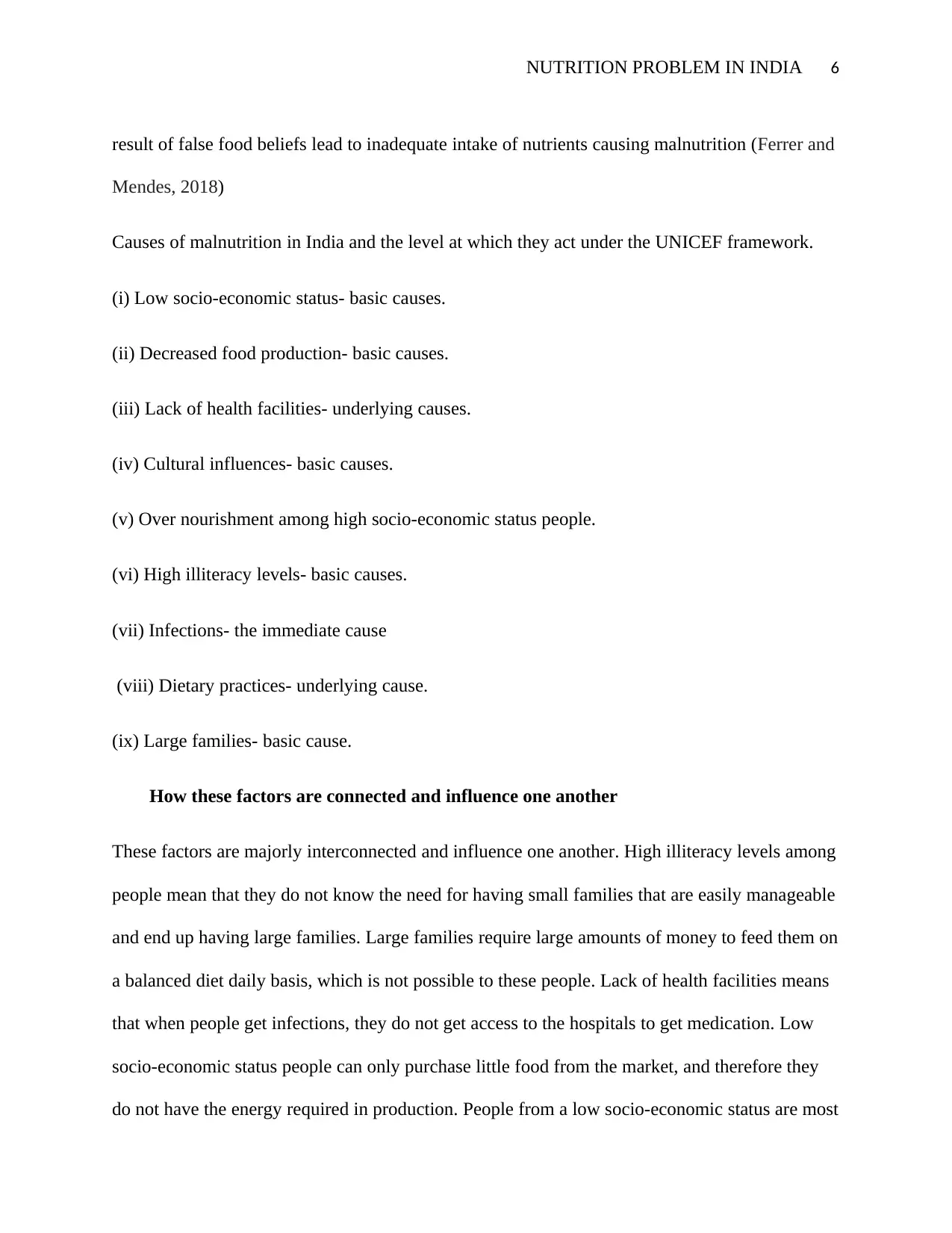
NUTRITION PROBLEM IN INDIA 6
result of false food beliefs lead to inadequate intake of nutrients causing malnutrition (Ferrer and
Mendes, 2018)
Causes of malnutrition in India and the level at which they act under the UNICEF framework.
(i) Low socio-economic status- basic causes.
(ii) Decreased food production- basic causes.
(iii) Lack of health facilities- underlying causes.
(iv) Cultural influences- basic causes.
(v) Over nourishment among high socio-economic status people.
(vi) High illiteracy levels- basic causes.
(vii) Infections- the immediate cause
(viii) Dietary practices- underlying cause.
(ix) Large families- basic cause.
How these factors are connected and influence one another
These factors are majorly interconnected and influence one another. High illiteracy levels among
people mean that they do not know the need for having small families that are easily manageable
and end up having large families. Large families require large amounts of money to feed them on
a balanced diet daily basis, which is not possible to these people. Lack of health facilities means
that when people get infections, they do not get access to the hospitals to get medication. Low
socio-economic status people can only purchase little food from the market, and therefore they
do not have the energy required in production. People from a low socio-economic status are most
result of false food beliefs lead to inadequate intake of nutrients causing malnutrition (Ferrer and
Mendes, 2018)
Causes of malnutrition in India and the level at which they act under the UNICEF framework.
(i) Low socio-economic status- basic causes.
(ii) Decreased food production- basic causes.
(iii) Lack of health facilities- underlying causes.
(iv) Cultural influences- basic causes.
(v) Over nourishment among high socio-economic status people.
(vi) High illiteracy levels- basic causes.
(vii) Infections- the immediate cause
(viii) Dietary practices- underlying cause.
(ix) Large families- basic cause.
How these factors are connected and influence one another
These factors are majorly interconnected and influence one another. High illiteracy levels among
people mean that they do not know the need for having small families that are easily manageable
and end up having large families. Large families require large amounts of money to feed them on
a balanced diet daily basis, which is not possible to these people. Lack of health facilities means
that when people get infections, they do not get access to the hospitals to get medication. Low
socio-economic status people can only purchase little food from the market, and therefore they
do not have the energy required in production. People from a low socio-economic status are most
⊘ This is a preview!⊘
Do you want full access?
Subscribe today to unlock all pages.

Trusted by 1+ million students worldwide

NUTRITION PROBLEM IN INDIA 7
likely not to educate their children. They grow up with no basic knowledge of nutrition and
therefore, most likely to be influenced by false cultural beliefs and superstitions on food
(Manyanga, 2017). This lead to inadequate intake of nutrients, causing malnutrition, and the
vicious cycle continues due to poverty.
Priorities for action to address the nutrition problems
In consideration of evidence-based programs, the priorities are to improve the nutrition and
health status of pregnant women, lactating women, and children of below five years of age. They
are increasing school enrollment and attendance of children (Black et al. 2016). The programs
are run in rural areas to provide supplementary nutrition for three hundred days a year. Special
nutrition programs should be integrated with the integrated child development services to ensure
that all children can assess the nutrition provided. Wheat based nutrition programs that supply
wheat to children below the age of six and expectant and lactating mothers should ensure that
measures are put in place for this to be a success. There have been reported cases of wheat theft
under this program that has not been adequately addressed, and the government needs to take
immediate action to resolve this. A program like the applied nutrition program that was
introduced to promote the production of protective foods, equip people with knowledge on
nutrition should be at the forefront of the government's agenda in terms of funding (Duggan,
2014). National nutritional anemia prophylaxis program that provides nursing mothers with one
tablet of folic acid and iron should be stepped up by the government by ensuring there are health
facilities that ensure pregnant women are able to access this services that address anemia.
A successful nutrition program in India
likely not to educate their children. They grow up with no basic knowledge of nutrition and
therefore, most likely to be influenced by false cultural beliefs and superstitions on food
(Manyanga, 2017). This lead to inadequate intake of nutrients, causing malnutrition, and the
vicious cycle continues due to poverty.
Priorities for action to address the nutrition problems
In consideration of evidence-based programs, the priorities are to improve the nutrition and
health status of pregnant women, lactating women, and children of below five years of age. They
are increasing school enrollment and attendance of children (Black et al. 2016). The programs
are run in rural areas to provide supplementary nutrition for three hundred days a year. Special
nutrition programs should be integrated with the integrated child development services to ensure
that all children can assess the nutrition provided. Wheat based nutrition programs that supply
wheat to children below the age of six and expectant and lactating mothers should ensure that
measures are put in place for this to be a success. There have been reported cases of wheat theft
under this program that has not been adequately addressed, and the government needs to take
immediate action to resolve this. A program like the applied nutrition program that was
introduced to promote the production of protective foods, equip people with knowledge on
nutrition should be at the forefront of the government's agenda in terms of funding (Duggan,
2014). National nutritional anemia prophylaxis program that provides nursing mothers with one
tablet of folic acid and iron should be stepped up by the government by ensuring there are health
facilities that ensure pregnant women are able to access this services that address anemia.
A successful nutrition program in India
Paraphrase This Document
Need a fresh take? Get an instant paraphrase of this document with our AI Paraphraser
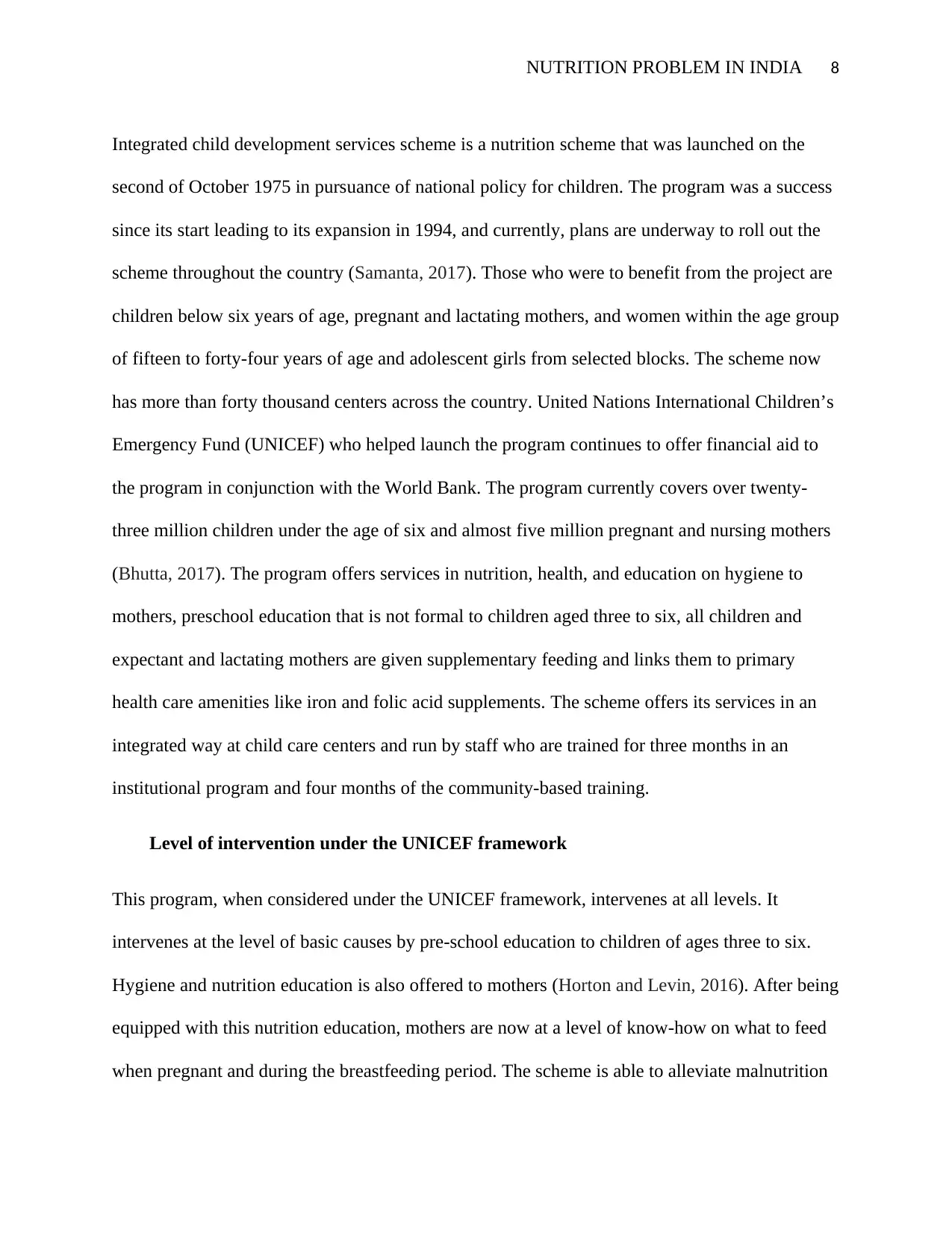
NUTRITION PROBLEM IN INDIA 8
Integrated child development services scheme is a nutrition scheme that was launched on the
second of October 1975 in pursuance of national policy for children. The program was a success
since its start leading to its expansion in 1994, and currently, plans are underway to roll out the
scheme throughout the country (Samanta, 2017). Those who were to benefit from the project are
children below six years of age, pregnant and lactating mothers, and women within the age group
of fifteen to forty-four years of age and adolescent girls from selected blocks. The scheme now
has more than forty thousand centers across the country. United Nations International Children’s
Emergency Fund (UNICEF) who helped launch the program continues to offer financial aid to
the program in conjunction with the World Bank. The program currently covers over twenty-
three million children under the age of six and almost five million pregnant and nursing mothers
(Bhutta, 2017). The program offers services in nutrition, health, and education on hygiene to
mothers, preschool education that is not formal to children aged three to six, all children and
expectant and lactating mothers are given supplementary feeding and links them to primary
health care amenities like iron and folic acid supplements. The scheme offers its services in an
integrated way at child care centers and run by staff who are trained for three months in an
institutional program and four months of the community-based training.
Level of intervention under the UNICEF framework
This program, when considered under the UNICEF framework, intervenes at all levels. It
intervenes at the level of basic causes by pre-school education to children of ages three to six.
Hygiene and nutrition education is also offered to mothers (Horton and Levin, 2016). After being
equipped with this nutrition education, mothers are now at a level of know-how on what to feed
when pregnant and during the breastfeeding period. The scheme is able to alleviate malnutrition
Integrated child development services scheme is a nutrition scheme that was launched on the
second of October 1975 in pursuance of national policy for children. The program was a success
since its start leading to its expansion in 1994, and currently, plans are underway to roll out the
scheme throughout the country (Samanta, 2017). Those who were to benefit from the project are
children below six years of age, pregnant and lactating mothers, and women within the age group
of fifteen to forty-four years of age and adolescent girls from selected blocks. The scheme now
has more than forty thousand centers across the country. United Nations International Children’s
Emergency Fund (UNICEF) who helped launch the program continues to offer financial aid to
the program in conjunction with the World Bank. The program currently covers over twenty-
three million children under the age of six and almost five million pregnant and nursing mothers
(Bhutta, 2017). The program offers services in nutrition, health, and education on hygiene to
mothers, preschool education that is not formal to children aged three to six, all children and
expectant and lactating mothers are given supplementary feeding and links them to primary
health care amenities like iron and folic acid supplements. The scheme offers its services in an
integrated way at child care centers and run by staff who are trained for three months in an
institutional program and four months of the community-based training.
Level of intervention under the UNICEF framework
This program, when considered under the UNICEF framework, intervenes at all levels. It
intervenes at the level of basic causes by pre-school education to children of ages three to six.
Hygiene and nutrition education is also offered to mothers (Horton and Levin, 2016). After being
equipped with this nutrition education, mothers are now at a level of know-how on what to feed
when pregnant and during the breastfeeding period. The scheme is able to alleviate malnutrition
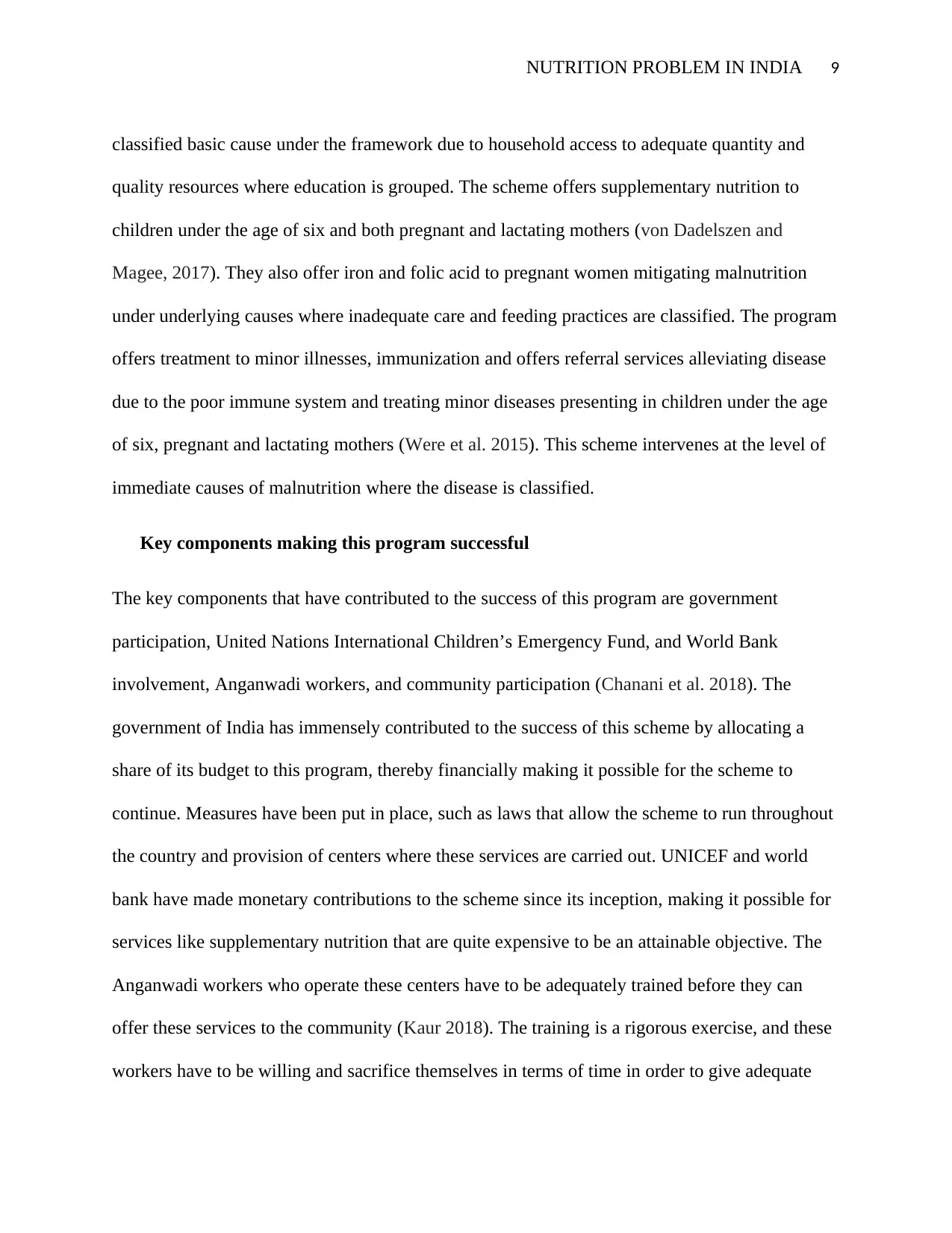
NUTRITION PROBLEM IN INDIA 9
classified basic cause under the framework due to household access to adequate quantity and
quality resources where education is grouped. The scheme offers supplementary nutrition to
children under the age of six and both pregnant and lactating mothers (von Dadelszen and
Magee, 2017). They also offer iron and folic acid to pregnant women mitigating malnutrition
under underlying causes where inadequate care and feeding practices are classified. The program
offers treatment to minor illnesses, immunization and offers referral services alleviating disease
due to the poor immune system and treating minor diseases presenting in children under the age
of six, pregnant and lactating mothers (Were et al. 2015). This scheme intervenes at the level of
immediate causes of malnutrition where the disease is classified.
Key components making this program successful
The key components that have contributed to the success of this program are government
participation, United Nations International Children’s Emergency Fund, and World Bank
involvement, Anganwadi workers, and community participation (Chanani et al. 2018). The
government of India has immensely contributed to the success of this scheme by allocating a
share of its budget to this program, thereby financially making it possible for the scheme to
continue. Measures have been put in place, such as laws that allow the scheme to run throughout
the country and provision of centers where these services are carried out. UNICEF and world
bank have made monetary contributions to the scheme since its inception, making it possible for
services like supplementary nutrition that are quite expensive to be an attainable objective. The
Anganwadi workers who operate these centers have to be adequately trained before they can
offer these services to the community (Kaur 2018). The training is a rigorous exercise, and these
workers have to be willing and sacrifice themselves in terms of time in order to give adequate
classified basic cause under the framework due to household access to adequate quantity and
quality resources where education is grouped. The scheme offers supplementary nutrition to
children under the age of six and both pregnant and lactating mothers (von Dadelszen and
Magee, 2017). They also offer iron and folic acid to pregnant women mitigating malnutrition
under underlying causes where inadequate care and feeding practices are classified. The program
offers treatment to minor illnesses, immunization and offers referral services alleviating disease
due to the poor immune system and treating minor diseases presenting in children under the age
of six, pregnant and lactating mothers (Were et al. 2015). This scheme intervenes at the level of
immediate causes of malnutrition where the disease is classified.
Key components making this program successful
The key components that have contributed to the success of this program are government
participation, United Nations International Children’s Emergency Fund, and World Bank
involvement, Anganwadi workers, and community participation (Chanani et al. 2018). The
government of India has immensely contributed to the success of this scheme by allocating a
share of its budget to this program, thereby financially making it possible for the scheme to
continue. Measures have been put in place, such as laws that allow the scheme to run throughout
the country and provision of centers where these services are carried out. UNICEF and world
bank have made monetary contributions to the scheme since its inception, making it possible for
services like supplementary nutrition that are quite expensive to be an attainable objective. The
Anganwadi workers who operate these centers have to be adequately trained before they can
offer these services to the community (Kaur 2018). The training is a rigorous exercise, and these
workers have to be willing and sacrifice themselves in terms of time in order to give adequate
⊘ This is a preview!⊘
Do you want full access?
Subscribe today to unlock all pages.

Trusted by 1+ million students worldwide
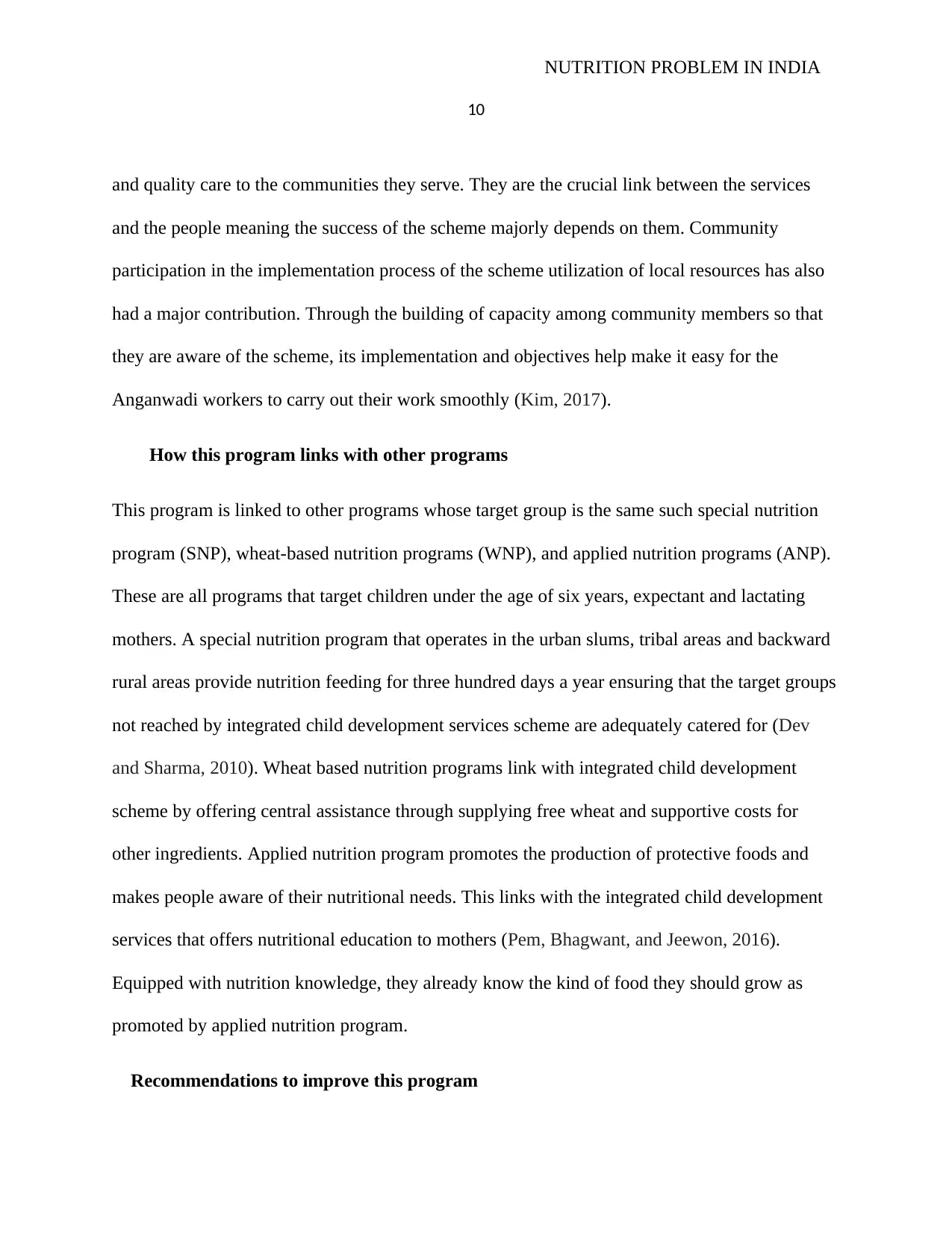
NUTRITION PROBLEM IN INDIA
10
and quality care to the communities they serve. They are the crucial link between the services
and the people meaning the success of the scheme majorly depends on them. Community
participation in the implementation process of the scheme utilization of local resources has also
had a major contribution. Through the building of capacity among community members so that
they are aware of the scheme, its implementation and objectives help make it easy for the
Anganwadi workers to carry out their work smoothly (Kim, 2017).
How this program links with other programs
This program is linked to other programs whose target group is the same such special nutrition
program (SNP), wheat-based nutrition programs (WNP), and applied nutrition programs (ANP).
These are all programs that target children under the age of six years, expectant and lactating
mothers. A special nutrition program that operates in the urban slums, tribal areas and backward
rural areas provide nutrition feeding for three hundred days a year ensuring that the target groups
not reached by integrated child development services scheme are adequately catered for (Dev
and Sharma, 2010). Wheat based nutrition programs link with integrated child development
scheme by offering central assistance through supplying free wheat and supportive costs for
other ingredients. Applied nutrition program promotes the production of protective foods and
makes people aware of their nutritional needs. This links with the integrated child development
services that offers nutritional education to mothers (Pem, Bhagwant, and Jeewon, 2016).
Equipped with nutrition knowledge, they already know the kind of food they should grow as
promoted by applied nutrition program.
Recommendations to improve this program
10
and quality care to the communities they serve. They are the crucial link between the services
and the people meaning the success of the scheme majorly depends on them. Community
participation in the implementation process of the scheme utilization of local resources has also
had a major contribution. Through the building of capacity among community members so that
they are aware of the scheme, its implementation and objectives help make it easy for the
Anganwadi workers to carry out their work smoothly (Kim, 2017).
How this program links with other programs
This program is linked to other programs whose target group is the same such special nutrition
program (SNP), wheat-based nutrition programs (WNP), and applied nutrition programs (ANP).
These are all programs that target children under the age of six years, expectant and lactating
mothers. A special nutrition program that operates in the urban slums, tribal areas and backward
rural areas provide nutrition feeding for three hundred days a year ensuring that the target groups
not reached by integrated child development services scheme are adequately catered for (Dev
and Sharma, 2010). Wheat based nutrition programs link with integrated child development
scheme by offering central assistance through supplying free wheat and supportive costs for
other ingredients. Applied nutrition program promotes the production of protective foods and
makes people aware of their nutritional needs. This links with the integrated child development
services that offers nutritional education to mothers (Pem, Bhagwant, and Jeewon, 2016).
Equipped with nutrition knowledge, they already know the kind of food they should grow as
promoted by applied nutrition program.
Recommendations to improve this program
Paraphrase This Document
Need a fresh take? Get an instant paraphrase of this document with our AI Paraphraser
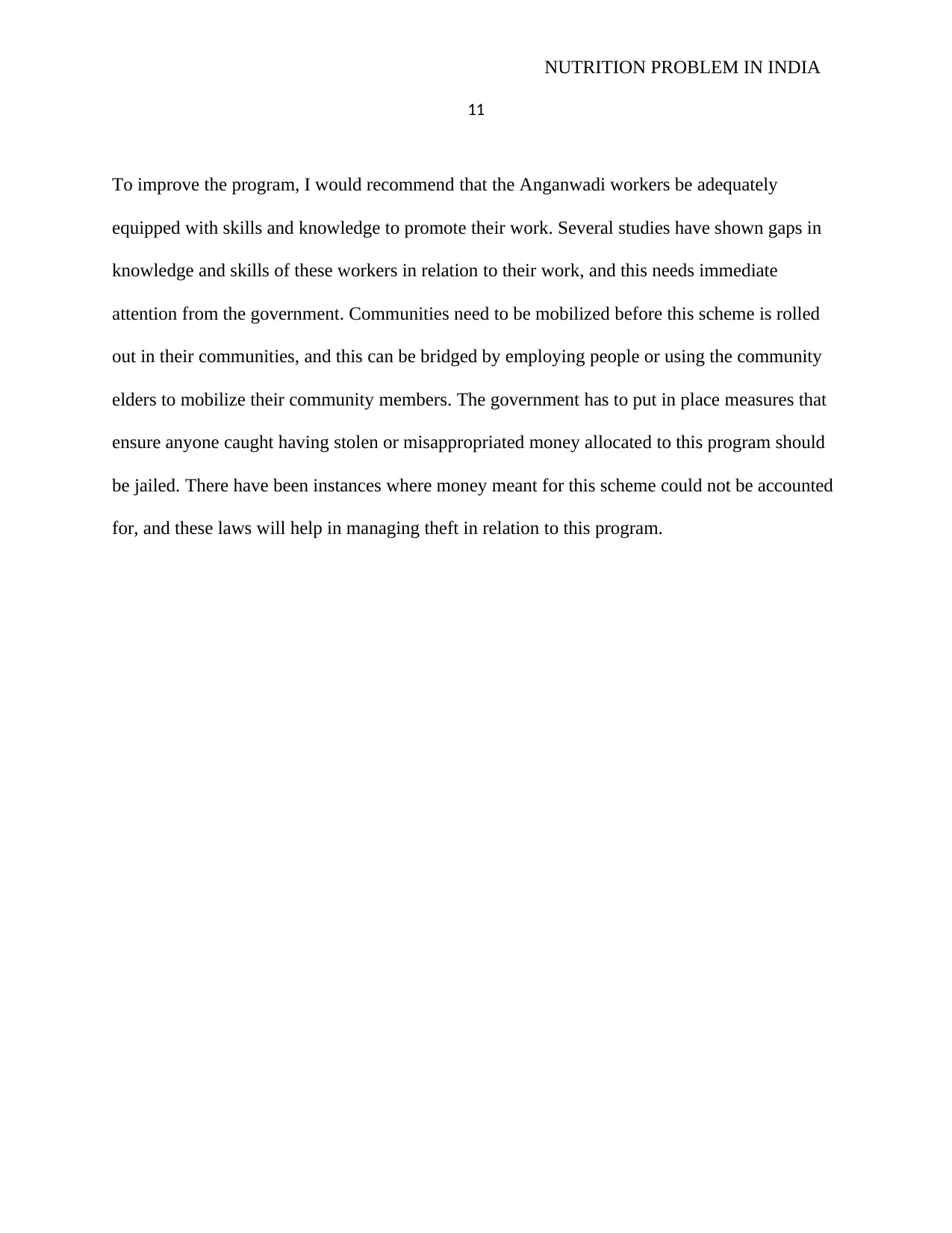
NUTRITION PROBLEM IN INDIA
11
To improve the program, I would recommend that the Anganwadi workers be adequately
equipped with skills and knowledge to promote their work. Several studies have shown gaps in
knowledge and skills of these workers in relation to their work, and this needs immediate
attention from the government. Communities need to be mobilized before this scheme is rolled
out in their communities, and this can be bridged by employing people or using the community
elders to mobilize their community members. The government has to put in place measures that
ensure anyone caught having stolen or misappropriated money allocated to this program should
be jailed. There have been instances where money meant for this scheme could not be accounted
for, and these laws will help in managing theft in relation to this program.
11
To improve the program, I would recommend that the Anganwadi workers be adequately
equipped with skills and knowledge to promote their work. Several studies have shown gaps in
knowledge and skills of these workers in relation to their work, and this needs immediate
attention from the government. Communities need to be mobilized before this scheme is rolled
out in their communities, and this can be bridged by employing people or using the community
elders to mobilize their community members. The government has to put in place measures that
ensure anyone caught having stolen or misappropriated money allocated to this program should
be jailed. There have been instances where money meant for this scheme could not be accounted
for, and these laws will help in managing theft in relation to this program.
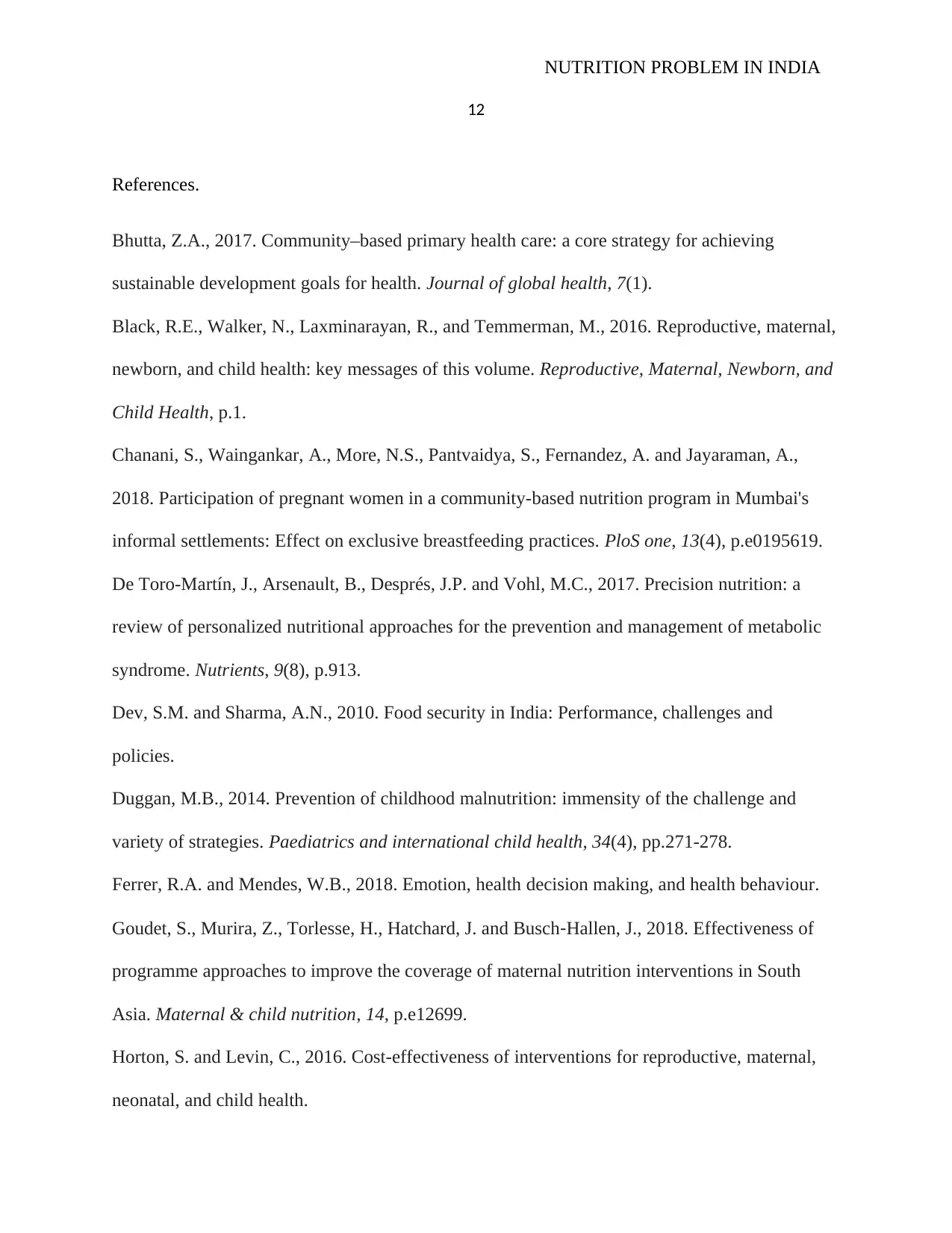
NUTRITION PROBLEM IN INDIA
12
References.
Bhutta, Z.A., 2017. Community–based primary health care: a core strategy for achieving
sustainable development goals for health. Journal of global health, 7(1).
Black, R.E., Walker, N., Laxminarayan, R., and Temmerman, M., 2016. Reproductive, maternal,
newborn, and child health: key messages of this volume. Reproductive, Maternal, Newborn, and
Child Health, p.1.
Chanani, S., Waingankar, A., More, N.S., Pantvaidya, S., Fernandez, A. and Jayaraman, A.,
2018. Participation of pregnant women in a community-based nutrition program in Mumbai's
informal settlements: Effect on exclusive breastfeeding practices. PloS one, 13(4), p.e0195619.
De Toro-Martín, J., Arsenault, B., Després, J.P. and Vohl, M.C., 2017. Precision nutrition: a
review of personalized nutritional approaches for the prevention and management of metabolic
syndrome. Nutrients, 9(8), p.913.
Dev, S.M. and Sharma, A.N., 2010. Food security in India: Performance, challenges and
policies.
Duggan, M.B., 2014. Prevention of childhood malnutrition: immensity of the challenge and
variety of strategies. Paediatrics and international child health, 34(4), pp.271-278.
Ferrer, R.A. and Mendes, W.B., 2018. Emotion, health decision making, and health behaviour.
Goudet, S., Murira, Z., Torlesse, H., Hatchard, J. and Busch‐Hallen, J., 2018. Effectiveness of
programme approaches to improve the coverage of maternal nutrition interventions in South
Asia. Maternal & child nutrition, 14, p.e12699.
Horton, S. and Levin, C., 2016. Cost-effectiveness of interventions for reproductive, maternal,
neonatal, and child health.
12
References.
Bhutta, Z.A., 2017. Community–based primary health care: a core strategy for achieving
sustainable development goals for health. Journal of global health, 7(1).
Black, R.E., Walker, N., Laxminarayan, R., and Temmerman, M., 2016. Reproductive, maternal,
newborn, and child health: key messages of this volume. Reproductive, Maternal, Newborn, and
Child Health, p.1.
Chanani, S., Waingankar, A., More, N.S., Pantvaidya, S., Fernandez, A. and Jayaraman, A.,
2018. Participation of pregnant women in a community-based nutrition program in Mumbai's
informal settlements: Effect on exclusive breastfeeding practices. PloS one, 13(4), p.e0195619.
De Toro-Martín, J., Arsenault, B., Després, J.P. and Vohl, M.C., 2017. Precision nutrition: a
review of personalized nutritional approaches for the prevention and management of metabolic
syndrome. Nutrients, 9(8), p.913.
Dev, S.M. and Sharma, A.N., 2010. Food security in India: Performance, challenges and
policies.
Duggan, M.B., 2014. Prevention of childhood malnutrition: immensity of the challenge and
variety of strategies. Paediatrics and international child health, 34(4), pp.271-278.
Ferrer, R.A. and Mendes, W.B., 2018. Emotion, health decision making, and health behaviour.
Goudet, S., Murira, Z., Torlesse, H., Hatchard, J. and Busch‐Hallen, J., 2018. Effectiveness of
programme approaches to improve the coverage of maternal nutrition interventions in South
Asia. Maternal & child nutrition, 14, p.e12699.
Horton, S. and Levin, C., 2016. Cost-effectiveness of interventions for reproductive, maternal,
neonatal, and child health.
⊘ This is a preview!⊘
Do you want full access?
Subscribe today to unlock all pages.

Trusted by 1+ million students worldwide
1 out of 14
Related Documents
Your All-in-One AI-Powered Toolkit for Academic Success.
+13062052269
info@desklib.com
Available 24*7 on WhatsApp / Email
![[object Object]](/_next/static/media/star-bottom.7253800d.svg)
Unlock your academic potential
Copyright © 2020–2025 A2Z Services. All Rights Reserved. Developed and managed by ZUCOL.





